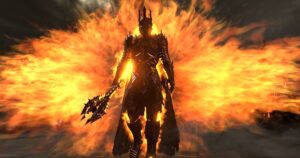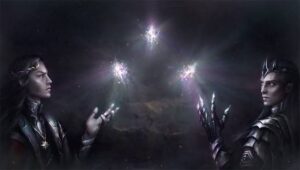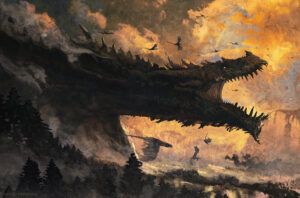CONTENT WARNINGS: MENTIONS OF RAPE AND INCEST
Middle-earth’s recorded history is divided up into four segments, each universally recognized and referred to as an “Age” of the world. The beginnings and endings of any given Age are determined not by a person or even a group of people, but by all peoples…for every Age has its own antagonist, a manifestation of evil so great it requires a coalition of Middle-earth’s inhabitants to defeat or eradicate forever, and when that happens, the reckoning of years resets to zero and history is allowed to flow inexorably onwards towards the last confrontation of god and devil in which Middle-earth itself will be unmade and a new one, a better one, will take its place.

The events depicted in Amazon’s upcoming series, The Rings Of Power, took place during the latter half of the Second Age, which ran on for three-thousand, four-hundred and forty-one years before ending abruptly with the defeat of Sauron by the Last Alliance of Elves and Men, at which point the Third Age began. Another three-thousand years after that, the Third Age ended with the downfall of Sauron in the War of the Ring (as told in The Lord Of The Rings), which immediately preceded the beginning of the Fourth Age. Importantly, the Fourth Age did not officially begin until a few years after Sauron’s downfall, when Galadriel, Elrond, and most of the High Elves in Middle-earth finally departed into the west and permitted the human race to take back the lands they had been occupying for centuries.
But today, we look back to a time before the beginnings of the Fourth, Third, or Second Ages, long before the Rings of Power were forged in Eregion and longer still before they were depowered or destroyed, a time known as the First Age…although in truth the First Age did not officially begin until there was a sun and a moon in the sky to make the reckoning of years easier for Men and Elves, and our story begins even further back, before there was a sun or a moon, before they had even been conceived of by their divine creators. Further back, and further back, through the Years of the Trees to the Years of the Lamps and to a time before time was measured.
The story of the First Age and the eons which preceded it is recounted in The Silmarillion – a collection of stories and legends published after J.R.R. Tolkien’s death by his youngest son, Christopher, who made it his life’s mission to track down all of his father’s scattered notes and stitch them together to form a somewhat cohesive narrative. Fair warning, even in its published form, The Silmarillion isn’t the most accessible entry-point into Tolkien’s legendarium. It’s a small book, but dense. It also includes information pertinent to Amazon’s The Rings Of Power, information that I shall do my best to highlight as I undertake today’s arduous task of summarizing The Silmarillion‘s contents for casual fans, or for anyone who doesn’t have the time or inclination to read the book but still wants to get the most out of The Rings Of Power.
(Quick disclaimer for all the hardcore fans out there, I will be referencing the published, “Flat-World” Silmarillion…and not the “Round-World” Silmarillion which J.R.R. Tolkien sketched out towards the end of his life, for two reasons; one being that the “Round-World” Silmarillion is a rough first draft of a story inconsistent with almost everything else in Tolkien’s legendarium, and lacking the polish it needed to withstand scrutiny; and the other being that the “Round-World” Silmarillion hinges on the rape of Arien, charioteer of the sun, and something about that just doesn’t sit right with me).
The First War
Before sun and moon, before the Trees or the Lamps or the kindling of the stars, the inhabitants of Middle-earth had no methods by which to measure the natural passage of time. However, because the sole inhabitants of Middle-earth were ageless immortal gods (divided into two classes; the Valar, or angelic powers, and the Maiar, or lesser spirits), they got along just fine using their own unique and incomprehensible system of Valian Years. In any case, they had bigger things to worry about. Melkor (later known as Morgoth by the Elves), one of the most powerful Valar in existence, sought to destroy the world while it was still fragile, and with an army of corrupted Maiar at his back he posed a formidable threat to the divine plan of the Valar. Although he could only tear down what others had built before him, the First Enemy kept the Valar engaged in an endless cycle of ruin and renewal that left them exhausted.
With the help of a young god named Tulkas, the Valar finally drove Melkor to the shadowy margins of Middle-earth where he could not trouble them for a time. To commemorate their victory, they erected two great towers – one in the far north, the other in the far south – and placed lamps in these towers to banish all shadows from the world. Where the light of the two lamps touched, there was a blessed land named Almaren, and the Valar dwelt here briefly. But the Years of the Lamps ended when Melkor returned out of the darkness, toppled the great towers, and spilled their fire across the verdant surface of Middle-earth until Almaren was utterly destroyed. Accepting their defeat, the Valar then retreated beyond the mountains of the Pelóri to a land separated from Middle-earth by a vast ocean – a land which they named Valinor.
Here, the Valar once again exerted their energy to bring forth two magnificent trees, Laurelin and Telperion, which emanated gold and silver light from their leaves, respectively. This light purified the land and cleansed it of all evil, but it could not escape through the mountains which encircled Valinor. Several of the Valar were not content with hiding behind walls while Melkor wreaked havoc in Middle-earth, and they stole out secretly to combat him or subverted him in other ways. Varda, the queen of the Valar, collected the dew of the Two Trees and scattered it across the sky, creating stars which pierced the dark clouds surrounding Middle-earth. Melkor hated the stars, and he hated Varda most of all the Valar.
The Awakening Of The Elves
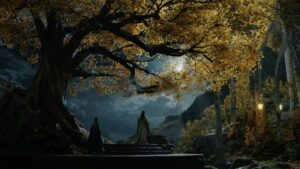
By the shores of Lake Cuiviénen in the far east of Middle-earth, the Elves were born first of all the Free Peoples. Their arrival had long been anticipated by the Valar…and by Melkor, who saw an opportunity to throw the divine plan into chaos if he slaughtered the Elves or ruined them as he ruined all things which he touched. Therefore, he sent his servants out into the wilderness to find the place of their awakening. The Elves had no weapons of their own with which to defend themselves, but they were unknowingly protected by the light of the stars.
Still, when the Valar finally found them, they insisted that the Elves come to Valinor where their safety could be ensured. Many followed the Valar out of fear of Melkor, though nearly as many stayed, or turned back, or were lost along the way for various reasons. One of these was Elu Thingol, a king of the Elves who was leading his people westward from Cuiviénen when he stumbled across Melian, a sorceress of the Maiar, in the woods of Nan Elmoth. They were instantly so enamored by each other that neither was able to move or speak for years, and many of Thingol’s people continued without him. When he and Melian finally emerged out of Nan Elmoth hand-in-hand, they found a few Elves still waiting for them and these became the subjects of Thingol and Melian’s realm in the hidden woods of Doriath, protected by Melian’s magic.
Those who made it to Valinor at long last were allowed to dwell wherever they wished within its confines or along its coasts, and they basked in the blessed light of the Two Trees…for which they were known as the Calaquendi or Light-elves, while those who never made it to Valinor were named the Moriquendi or Dark-elves, because they chose to remain in the darkness of Middle-earth. The rift between the Calaquendi and the Moriquendi was never small, but it only widened throughout the First Age.
The Years Of The Trees
In Valinor, the Calaquendi became further divided into smaller subgroups – the most significant being the Noldor (Deep-elves), who dwelt in the city of Tirion in Valinor’s only mountain pass, the Vanyar (Fair-elves), who settled on the slopes of Valinor’s highest mountain, Taniquetil, and the Falmari (Wave-folk), who lived by the shores of the Sundering Sea and on various islands just off the coast of Valinor. The Noldor were great craftspeople, smiths, jewelers, sculptors, alchemists, architects, and drivers of technological progress – they learned much from Aulë, blacksmith of the Valar. The Vanyar were primarily poets and singers, and they were loyal disciples of Varda and her husband, Manwë, who lived at the summit of Taniquetil. The Falmari revered Ulmo, lord of the seas, and they were shipwrights and mariners with a gift for music.
The greatest of the Noldor was Fëanor, the circumstances of whose birth were…complicated. His father Finwë was High King of the Noldor, and his mother Míriel was a talented embroiderer – but in giving birth to Fëanor, her first and only child, Míriel spent so much of her energy that her spirit fled from her body shortly afterwards and refused to return, though Finwë and the Valar begged her to return. Hers was the first natural death in Valinor, and it caused the Elves great consternation. Finwë eventually remarried to Indis of the Vanyar and had several more children, but Fëanor resented his stepmother and stepsiblings, and wished them harm for their influence on his father.
His was no Cinderella story, however, for Fëanor’s stepsiblings were by all accounts lovely people, and they and their children were among the great heroes of the First Age. Fingolfin, and his sons Fingon and Turgon, were all mighty warriors and statesmen. Finarfin, his son Finrod, and his daughter Galadriel, were both wise and strong. I’m sure that Írimë and Findis, Finwë’s daughters, had their own virtuous traits, but all we know about Írimë is that she later joined the Rebellion of the Noldor, and we’ll probably never find out what happened to her because Tolkien didn’t make a point of recording women’s deeds in Middle-earth.
I’m getting ahead of myself. In Valinor, during the Years of the Trees, family reunions could occasionally get a little tense but Fëanor and his seven sons usually avoided their stepfamily entirely and spent their time working on various projects – including the creation of the Tengwar alphabet, the far-seeing palantíri, and the Silmarils. The Silmarils were Fëanor’s most prized possession, for within these three radiant gemstones he had captured some of the light of the Two Trees and there it remained forever undimmed while the Years of the Trees themselves drew swiftly to a close.
The Theft Of The Silmarils
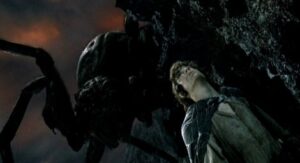
Remember Melkor? The Valar sure did, and while they were busy organizing the evacuation of the Elven population of Middle-earth, they were simultaneously ripping apart the lands vacated or soon-to-be-vacated by the Elves in their search for Melkor. When they found him, cowering in the underground fortress of Utumno, they threw him in chains and dragged him back to Valinor…only for the lord of the Valar, Manwë, to take mercy on him and decree that he should be allowed to roam freely throughout Valinor in the hopes that the light of the Two Trees would cleanse the evil from him. It did not. It only made Melkor angrier and more hateful and envious of the Valar when he saw all that they had created that he could not ruin with his touch, and he detested the Elves because their very presence in Valinor was a testament to his failure.
And yet, Melkor correctly perceived that there were cracks in the cheery façade of Valinor, ones that could grow to become gaping rifts. Going amongst the Elves, he spread scurrilous rumors that the sons of Finwë were plotting against each other, knowing full well how Fëanor and Fingolfin would react when these rumors reached their ears, as they soon did. Fingolfin became protective of his family, and began forging weapons and armor in case the need should ever arise for him to fight, while Fëanor became equally as protective of the Silmarils he had made, and he personally locked them away in the northern stronghold of Formenos. The two quarreled in the streets of Tirion, and at one point even drew blades on each other. Fëanor hated Melkor, but knew not that he played into the dark lord’s hands by acting irrationally out of fear and anger.
The Valar, on the other hand, realized at once that Melkor was behind all of this, and they went to capture him – only to find that he had seemingly fled from Valinor back to Middle-earth by way of a land-bridge in the far north. In truth, he had crept away into the lands south of Valinor, where he sought out the ancient spider goddess Ungoliant, who fed on light itself. They conspired together to obtain the light of the Two Trees, which Melkor hated and Ungoliant hungered for – and as part of their deal, Melkor even promised her the light of the Silmarils.
They waited until the next reunion of Finwë’s sons to make their move, for Melkor knew that Fëanor was still in a fragile state of mind and would lash out in anger once he heard what had been done. Fëanor was actually in an uncharacteristically good mood when the day started, and even shook Fingolfin’s hand. But while they were partying, Melkor and Ungoliant returned to Valinor and approached the Two Trees. Melkor made deep incisions in their trunks, and Ungoliant drank from them until the Trees withered and died, and their light was sucked from the sky. The Elves and the Valar panicked in the sudden darkness, and by the time they had found their way to the green mound where the Trees had grown, Melkor and Ungoliant had already struck their next target – Formenos.
There, Melkor slew Finwë, High King of the Noldor, and he took the Silmarils for himself. He refused to feed them to Ungoliant as he had promised, and in her frustration she stung him and wrapped him in webs, and attempted to devour him alive – luckily for him, he screamed so loudly that a pack of Balrogs heard him and came to his aid. Ungoliant fled into the far south of Middle-earth, stopping just long enough to spawn a couple hundred-thousand equally repulsive offspring – including Shelob, the spider who guarded Mordor in the late Third Age – before eating herself in desperation. Melkor, however, returned to his old fortresses in Middle-earth and hunkered down, waiting for the Elves to carry out the next part of his plan.
The Rebellion Of The Noldor
When Fëanor learned about the theft of the Silmarils and the death of his father, he was filled with rage. He declared himself High King of the Noldor on the spot (although most of the Noldor rejected him, and claimed Fingolfin as their king), and gave Melkor the name Morgoth (“Black Foe”) which was used ever afterwards. The Noldor weren’t overly fond of Fëanor, but they hated Morgoth more in this moment and they all wanted revenge for the senseless killing of the Trees. And Fëanor offered them an opportunity for vengeance that the Valar would have denied them – to leave Valinor and pursue Morgoth into Middle-earth, and take back the Silmarils by force.
The very idea of going to war – against one of the Valar, no less – was unfamiliar to the Elves who had mostly lived sheltered lives in Valinor under the care of the gods, but none could deny that the Valar had failed to protect them this time, and might again. So they followed Fëanor, and left. It was a spontaneous decision, and one that many would come to regret in later years, but at the time it seemed like the only option available to them. Of Finwë’s children, only Finarfin and Findis remained in Valinor…and all of Finarfin’s children went with Fëanor, Galadriel most eagerly. She didn’t even care about the Silmarils necessarily, she just wanted to see Middle-earth.
The Valar were not too happy about any of this, and repeatedly warned the Elves that they would be following Fëanor into exile – and maybe, if they had promised to take action against Morgoth right then and there, while he was still weak from his fight with Ungoliant and his armies were untested, many tragedies could have been avoided and the Elves would have agreed to stay. But they chose to mourn ineffectively over the withered stumps of the Two Trees while Morgoth gathered his strength. So the Elves kept walking.
Eventually, they got tired of walking and Fëanor suggested that they borrow some ships from the Falmari who lived in Alqualondë on the eastern coast of Valinor. The Falmari told him to get lost, but Fëanor was pretty set on the idea by now and he wanted to teach the Falmari a lesson for getting in between him and his precious Silmarils, so he and his sons crept into the havens of Alqualondë and attempted to steal the ships. The Falmari resisted, swords were drawn, and the blood of Elves was spilled by Elves for the first time. This terrible moment was referred to as the Kinslaying.
At last, the Falmari were defeated and Fëanor took their ships – although many of his followers refused to board them, out of shame. Galadriel and Finrod, whose mother was Falmari, even helped defend Alqualondë during the Kinslaying. But they could not turn back and face the judgement of the Valar, so they continued along the shores of Valinor, marching parallel to Fëanor and his sons in their stolen ships. Fëanor had never liked Galadriel, and he was probably wary she would betray him to his doom, so when they reached the cold northern wastelands of the world he took the ships and set out across the ocean with his sons, leaving most of the Noldor stranded on the beaches. They followed, by way of an aforementioned land-bridge. Many perished, but Galadriel and Finrod were as strong-willed as Fëanor and they refused to turn back.
The War Of The Jewels Begins
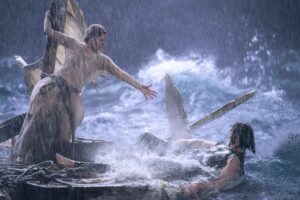
Upon reaching Middle-earth, almost the first thing that Fëanor did was rush headfirst into battle and get himself killed by a Balrog. It is quite possibly one of the most anticlimactic deaths in all of fantasy literature, and that is its tragedy. If Fëanor had been content to make weapons and not to wield them, he would probably have devised machines capable of shredding Morgoth’s armies and obliterating his fortifications within a few years. Mind you, whatever temporary peace such weapons brought about would likely have been outweighed by the far more devastating consequences of their creation…but anyway, I’m getting distracted by “what if?” scenarios.
Though Fëanor was dead, hope was not yet lost. For soon thereafter, the Sun and Moon rose out of Valinor into the sky (which until that point was dark and dotted with stars, as you may remember), and Morgoth’s armies fled before the bright lights in the sky. You see, all that time spent weeping over tree-stumps had finally paid off for the Valar as they were able to resurrect a single fruit of Laurelin and a single flower of Telperion that both contained a faint remnant of their light, and these they placed in vessels crafted by Aulë, and these were then given to the Maiar Arien and Tilion to carry across the sky for all eternity.
With the first sunrise, the Elves in Middle-earth began to measure time in days, and the First Age officially began. They never loved the sun as they did the stars and the memory of the True Light, but they were thankful for it – and none more so than Galadriel and Finrod, and all those whom Fëanor had left to die in the far north, for warmed by the sun’s rays they marched on with renewed vigor and determination, and they came at last into Middle-earth and found that Morgoth’s armies were afraid of the sun and fled before them. Fingolfin, now recognized by all as High King of the Noldor, made it all the way to the gates of Morgoth’s fortress city, Angband, before stopping to rest.
A mere sixty years later, with the help of Fëanor’s eldest son Maedhros, Fingolfin defeated Morgoth’s forces in Dagor Aglareb (“The Glorious Battle”). He slaughtered his enemies so thoroughly that Morgoth could not – and would not – attempt open assault against him for hundreds of years afterwards, instead relying on Elves under his bewitchment to break the Long Peace and the Siege of Angband while he cowered underground and worked on new evils.
The Long Peace
Behind the walls and fortresses built by Fingolfin to watch Angband day and night, the Elves under his protection flourished in the lands of Beleriand…and if that name doesn’t sound familiar, it’s probably because it’s not on the map of Middle-earth in The Lord Of The Rings. Well, pieces of it are, but none of the kingdoms established by the Elves during the Long Peace, none of their cities and high towers, none of their villages and farms…nothing but memories of a time when the Elves thought, naively perhaps, that they could build something lasting in Middle-earth.
It’s around this time that most of the major players in The Silmarillion went their separate ways. Fingolfin and his son Fingon settled in the cold gray hills of Hithlum, where they could most easily guard the northern entrances to Beleriand. Fingon’s brother, Turgon, constructed the city of Gondolin in a hidden valley east of Hithlum, walled by mountains. Galadriel went to Doriath, seeking instruction from Melian of the Maiar, and soon became a capable sorceress in her own right. Finrod carved out the city of Nargothrond in the cliffs overlooking the River Narog, with help from the Dwarves of the Blue Mountains.
Finrod had a gift for communicating with the other Free Peoples of Middle-earth. He was not the first Elf to enlist the help of the Dwarves in building and delving (Thingol had already done so), but he was one of the few who remained on good terms with the Dwarves and never cheated or deceived those who worked for him. Indeed, much like his sister Galadriel he appears to have viewed the Dwarves as powerful allies in the fight against Morgoth. He was also the first Noldor Elf and the first of the Calaquendi in general to encounter Men wandering in Beleriand, and he befriended them at once. A human man named Bëor even lived with him in Nargothrond for many years (and history will say they were roommates).
The meeting of Finrod and Bëor is a crucial moment in the histories of Middle-earth, establishing the close relationship between Elves and Men that endured throughout the First Age and well into the Second. Finrod ensured that Bëor’s people were given lands of their own, and they received the protection of the Elves in exchange for their aid in maintaining the Long Peace. These Men became the first Elf-friends.
Dagor Bragollach
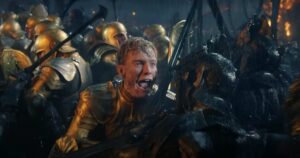
Almost four-hundred years after the Dagor Aglareb, Morgoth had his vengeance on the Elves for the humiliation they had caused him. A river of molten fire spewed forth from Angband’s open gates, flowing across northern Beleriand until it crashed against the walls and fortifications that Fingolfin had built. Breaking the Siege of Angband, Morgoth’s forces slaughtered the Elven guards that had long stood watch, and the Elven commanders were separated from their troops in the chaos. Finrod would have been killed, had not one of Bëor’s descendants, a man named Barahir, intervened to save his life.
This was the Dagor Bragollach (“Battle of Sudden Flame”), and it marked the end of the Long Peace that Fingolfin had worked so hard to maintain. As the High King of the Noldor looked out from the hills of Hithlum and watched Morgoth’s forces gaining ground in Beleriand, mowing down armies of Men and Elves as they came, he despaired. Waiting for no counsel, he rode to the gates of Angband and challenged Morgoth to a duel that he did not hope to win. Morgoth came, and flailed at him with the Hammer of the Underworld, Grond, but for a while Fingolfin evaded his heavy blows. He stabbed Morgoth repeatedly, until he stumbled in exhaustion, and then Morgoth crushed him underfoot.
Upon Fingolfin’s death, his son Fingon became High King of the Noldor, but the Noldor had been scattered far and wide across lands overrun by orcs and other fell beasts as they fled before the fires of Angband. Men, too, had been forced out of their lands and now sought refuge in the homes of their Elven friends. One of these was Beren.
Beren And Lúthien
Beren, son of Barahir, came to the hidden woods of Doriath a few years after the Dagor Bragollach and somehow passed through the magical barriers which Melian had put in place to safeguard her kingdom. There, he came upon Melian and Thingol’s daughter, Lúthien Tinúviel, dancing in a glade, and fell in love with her at first sight. After spending a few days with him in the forest, Lúthien led him back to the underground city of Menegroth where she and her family dwelt, and there Beren declared that he intended to marry Lúthien if she would have him. No Elf and human had ever wedded before, but Lúthien would have agreed right then and there had not Thingol interrupted.
Thingol informed Beren that if he really wanted Lúthien’s hand in marriage, he would first have to go to Angband and pry one of the three Silmarils from Morgoth’s iron crown. Thingol knew this was impossible, Beren knew it was impossible, everyone knew it was impossible. But for love of Lúthien, Beren set out from Menegroth at once. He sought the aid of Finrod, who was a master of disguises, and together they traveled disguised as orcs across Beleriand until they were accosted near the Isle of Werewolves, where Morgoth’s lieutenant Sauron dwelt. Sauron was a far greater sorcerer than Finrod, and he quickly stripped their disguises away.
But what neither Sauron nor Finrod realized was that another sorcerer approached, and she was greater than any of them. For Lúthien Tinúviel had run away from Menegroth to follow Beren into peril, and she came to Tol Sirion and used her own magic to defeat Sauron and tear down his fortress brick-by-brick. She was too late to save Finrod, who died in Beren’s arms, but together they carried the Elven king’s body out into the sunlight and laid him to rest in a cairn (Galadriel apparently visits this location in The Rings Of Power, although Amazon probably doesn’t have the rights to tell the full story of Finrod’s death).
Using Lúthien’s magic to disguise themselves as a werewolf and a vampire, respectively, Beren and Lúthien together came to Angband and passed through the gates, becoming the first of the Free Peoples to do so of their own volition. Lúthien then sang before the throne of Morgoth, and with her power alone caused the Dark Lord’s head to bow and his eyes to close, sending him toppling to the ground. Beren pried a single Silmaril from his crown (he tried for all three, but his knife broke), and they just barely escaped before Morgoth awoke from his slumber. But the wolf guarding the gates of Angband lunged at Beren and ripped off his hand which carried the Silmaril, swallowing the precious jewel.
Returning to Menegroth, Beren declared that technically he was still holding the Silmaril in his hand – and Thingol had never said his hand needed to be attached to his body. At this point, Thingol realized that nothing he did or said would ever prevent Beren and Lúthien from being together, so he permitted them to be married. And in the end, he got the Silmaril he had originally asked for – because the wolf came back, searching for Beren, and though he was fatally injured in the ensuing fight, he lived long enough to slice open the wolf’s stomach, reach in, and pull out the bloody Silmaril which he placed in Thingol’s hand.
But when Lúthien felt her husband die, she went alone to the underworld and sang another song – this time a song of love unbreakable which moved Mandos, the god of the dead, to tears. He allowed Beren to live again and be with Lúthien, and they remained together for many years until the time of Beren’s death could no longer be postponed, and then Lúthien chose to become a mortal woman and die alongside him, so that they would never be parted. The Silmaril which Beren had brought back from Angband remained in Menegroth, where Thingol hoarded it.
The End Of The War Of The Jewels
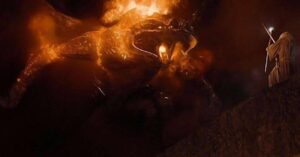
Fingon died a mere sixteen years after ascending to the throne, in the Nirnaeth Arnoediad (Battle of Unnumbered Tears), making his brother Turgon High King of the Noldor – although by this time most of the Noldor in Beleriand had fled to havens and refugee-camps on the shores of the Sundering Sea, far beyond Turgon’s jurisdiction as King of Gondolin. He would not leave the hidden city and risk endangering its peace, so while he avoided capture by Morgoth he did very little to help his people. Círdan the Shipwright, who protected the seaside havens, was no warrior, and Galadriel, who could probably have mustered the Noldor under her banner if she so desired, had already departed Beleriand and ventured further east into Middle-earth.
One by one, the kingdoms of the Elves fell – and not all to Morgoth, although he benefited from each loss they suffered. In Doriath, Thingol was murdered by Dwarves in a dispute over the Silmaril, and its location was betrayed to the sons of Fëanor, who ransacked Menegroth in their hunt for the stone which belonged to them by rights. Grieving her husband’s death, Melian departed Middle-earth, offering no further aid to her people or even her own great-granddaughter Elwing, who took the Silmaril and fled to the shores of the sea.
Around the same time, a wingless telepathic dragon named Glaurung entered Nargothrond and killed or enslaved most of its inhabitants. Glaurung was later slain by a man named Túrin, who shortly thereafter took his own life after learning from Glaurung that he had unintentionally fathered a child with his sister, Nienor, who threw herself off a cliff when she found out what had happened. Lovely story. I wish I had the time to tell it in full.
Before long, Gondolin was the last city left standing in Beleriand – but it outlasted Menegroth by only four years. In that time, Turgon’s nephew was captured by Morgoth and tortured until he divulged the location of the city, and then Gondolin’s fate was sealed. The city fell in a single night, and Turgon was buried underneath the wreckage of his palace. His daughter, Idril, escaped by way of a secret tunnel she and her human husband had built, and together with their young son Eärendil they made their way to the havens by the sea with a few other survivors. Some had escaped through the mountains encircling Gondolin, though not without great loss of life. An elf named Glorfindel died after falling into a ravine with a Balrog, but he was later resurrected (what is it about killing Balrogs that earns you a second chance at life in Middle-earth?).
The Voyage Of Eärendil
Arriving at the havens by the sea, Idril and her husband brought word of Turgon’s death. After a bit of digging through genealogical charts, it was decided that a young elf named Gil-galad, son of Galadriel’s younger brother Orodreth, was now High King of the Noldor because there were no better options and the Noldor stubbornly refused to let women take the title. Gil-galad had lived a fairly sheltered life with his guardian Círdan, and did virtually nothing as High King until the beginning of the Second Age, so you can forget about him for now.
More importantly, it was here that Idril’s son Eärendil met Elwing, the granddaughter of Lúthien Tinúviel, and they fell in love and got married. Elwing had two sons with Eärendil, named Elrond and Elros – and if you don’t already know those names, you should definitely file them away in the back of your head because The Rings Of Power is as much about the two of them as it is about Galadriel. But in all this time, the sons of Fëanor had never stopped searching for the Silmaril that had mysteriously disappeared from Menegroth – and when they learned that Elwing had escaped to the sea and started a family, they pretty quickly determined that she must still have it. So they went there and did what Fëanorians do best, which is slaughter their entire extended family.
Except they still didn’t get the Silmaril, because Elwing threw herself into the sea and was rescued by the god Ulmo, who transformed her into a sea-bird with the Silmaril upon her breast (somehow). Eärendil escaped in a ship, which he steered westward towards Valinor. Their sons, Elrond and Elros, were initially taken hostage but later adopted by Maedhros, one of the two sons of Fëanor who survived this Second Kinslaying. He felt pretty bad about the whole thing, and was getting sick and tired of chasing gemstones for his dead father’s sake, but he had sworn an unbreakable oath so he and his brother Maglor stayed there by the sea waiting for Elwing to get tired and come back to land.
Elwing never returned to Middle-earth, however. She found Eärendil’s ship in the middle of the ocean, transformed back into a woman, and used the Silmaril to light a path across the Sundering Sea to Valinor. They each had a part to play in what happened next, for Eärendil trekked up Taniquetil and demanded an audience with Varda and Manwë, while Elwing went to Alqualondë and convened the leaders of the Calaquendi. By sharing the tales of their hardships and their triumphs, their joys and their sorrows, they convinced the Valar and the Valinorean Elves to return to Middle-earth one last time and help rid the world of darkness.
The War Of Wrath
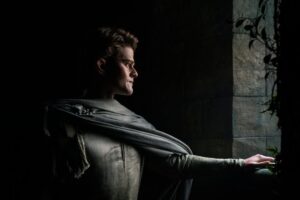
A short time later, Eärendil returned over the Sundering Seas wearing the Silmaril on a circlet, but this time his ship was lifted into the sky by the winds of Manwë, so high that the Elves of Middle-earth saw what they thought was a star rising out of the west. Morgoth cursed at the sight of it, but in his arrogance he had forgotten what it felt like to be truly afraid. His forces were in control of all of Beleriand, Angband was still impenetrable, and the Elves had no capable leaders (sorry, Gil-galad). The Noldor didn’t stand a chance against him.
But the Valar did, and it was their army which rose out of the sea at Eärendil’s back and spilled across Beleriand with the force of a thousand tidal waves. The Elves of Tirion were there, led by Finarfin, and they tore through Morgoth’s forces while the Valar went ahead and threw down the gates and walls of Angband. In a last-ditch effort to save his own skin, Morgoth unleashed a colossal dragon named Ancalagon that he had bred for war, but Eärendil and the Eagles of Manwë killed it, and it broke through Angband’s ceilings when it fell, killing almost everyone and everything inside. Morgoth survived, but when the Valar found him they showed no mercy. According to the published Silmarillion, they cut off his feet, tied him in chains, used his crown as a collar for his neck, and tossed him unceremoniously into the Void. In another version of the story, they beheaded him right then and there.
The Aftermath
With the downfall of Morgoth, the First Age ended and the Second Age began. Beleriand had been destroyed, trampled into the sea by the Valar, and all that remained of it were a handful of islands – the highlands of Dorthonion, the hill of Himring where Maedhros had lived, a few sacred spaces and inviolate tombs. There was nothing left there for the Elves, so they followed Galadriel east into the lands of Middle-earth you may recognize from maps. The Blue Mountains that had formed the eastern boundary of Beleriand now faced westward across open ocean, and about their feet in the land of Lindon lived many refugees in the care of King Gil-galad.
The Valar and their armies returned over the sea to Valinor, but not before offering pardons to the Elves for their actions during the Rebellions and in the Kinslayings which followed. Galadriel, Gil-galad, and many other Elves refused these pardons, desiring more than ever to make Middle-earth beautiful. Half-Elves like Elrond and Elros were offered a different choice, to determine for themselves whether they wished to be counted as Elves or Men. Elrond chose to be immortal like the Elves, while Elros chose the mortality of Men. And still others, like Morgoth’s lieutenant Sauron, were offered the choice to return to Valinor and be judged by Manwë for their crimes. Sauron side-stepped this choice entirely and hid until the Valar left.
As for the Silmarils, one remained with Eärendil in the sky, but the other two were stolen by the sons of Fëanor amidst the chaos, and they paid for this last reckless deed with their lives and their sanity. Maedhros’ hand was scorched by the Silmaril he carried, and eventually he threw himself into a pit of fire to end his suffering, taking the jewel with him to the heart of the earth. Maglor tossed the other Silmaril into the sea and remained by the shore forever, unwilling to die and unable to continue living. In the Second Age, only one Fëanorian still walked the earth – a grandson of Fëanor named Celebrimbor, the craftsman who forged the Rings of Power.
And…that’s it, that’s the First Age in a nutshell. I think you’re all caught up now. Obviously, I’ve left out a few details and glossed over stories that sprawl across entire chapters in The Silmarillion, but I’ve touched on all the most important bits – certainly everything and anything I expect to be referenced in The Rings Of Power. Remember that Amazon apparently doesn’t have the rights to The Silmarillion, so the versions of these stories they’ll tell will probably be even more vague and condensed than how I’ve presented them; I’m just giving you more context so you can pick up on any little clues the writers and production designers might have scattered about for hardcore fans.
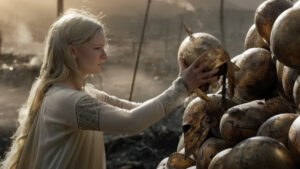
Anyway, that took a while to write and I’m starting to understand how Míriel felt after giving birth to Fëanor (gods above, it’s been three whole days since I wrote that line), so depending on what else happens between now and September 2nd this might be one of the last few Rings Of Power posts before the premiere of the first two episodes. If there’s anything else you want me to write about before then, leave it in the comments below and don’t forget to share all those thoughts, theories, and opinions I’m always hounding you about.
See you in Middle-earth, folks.
